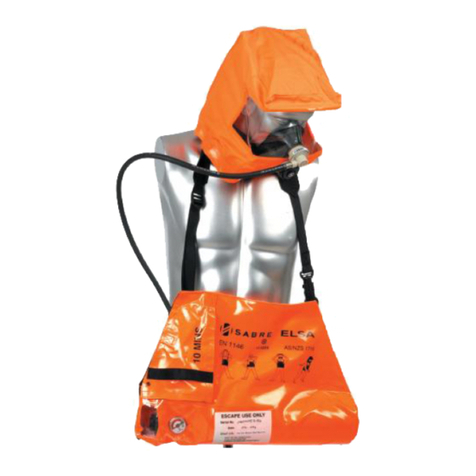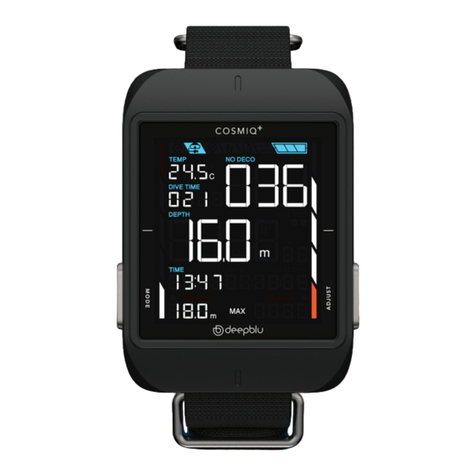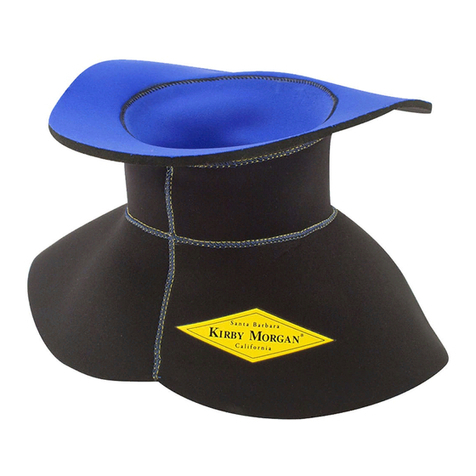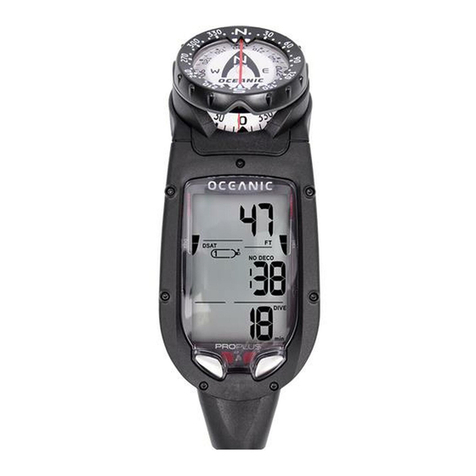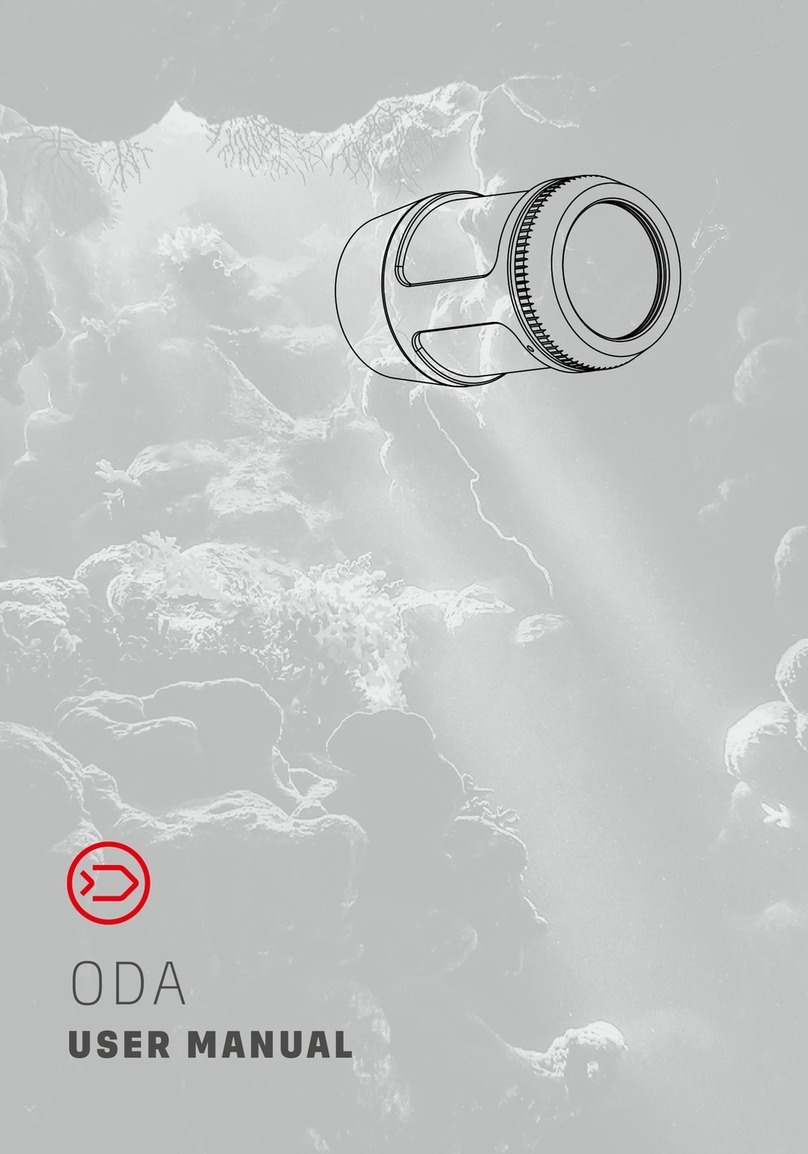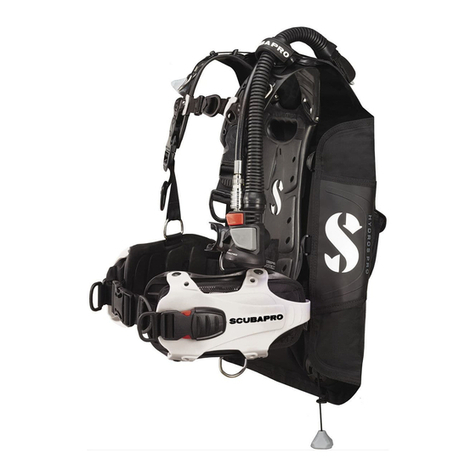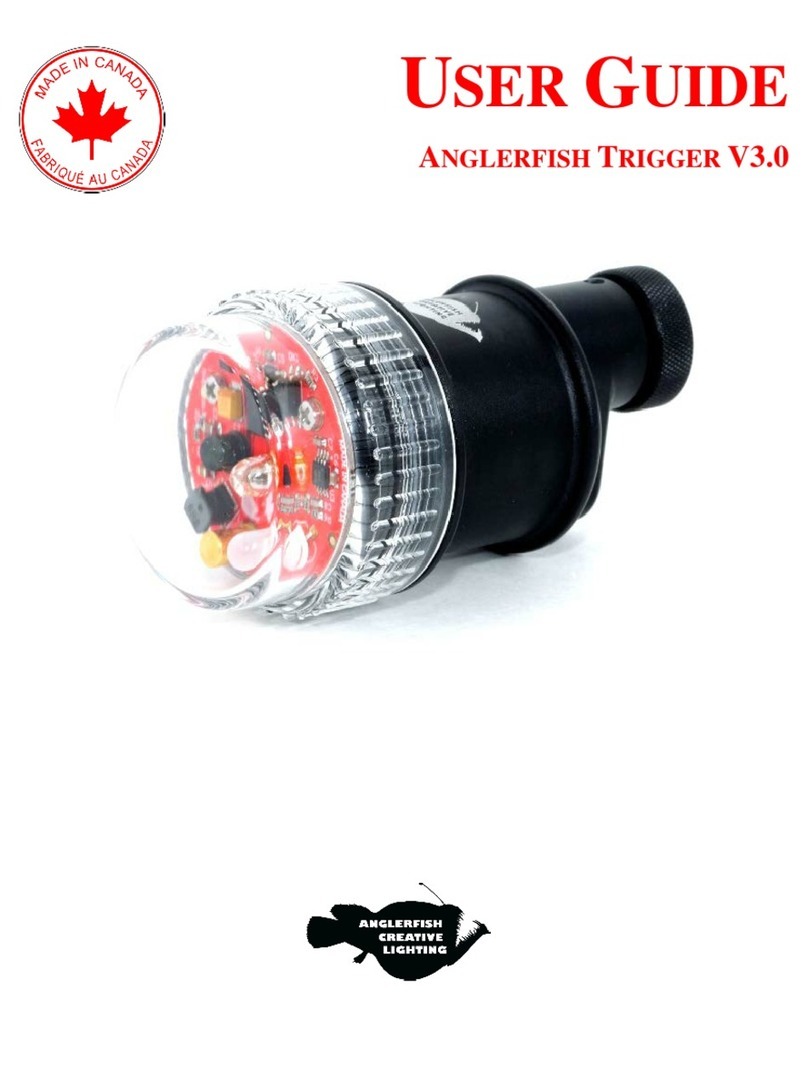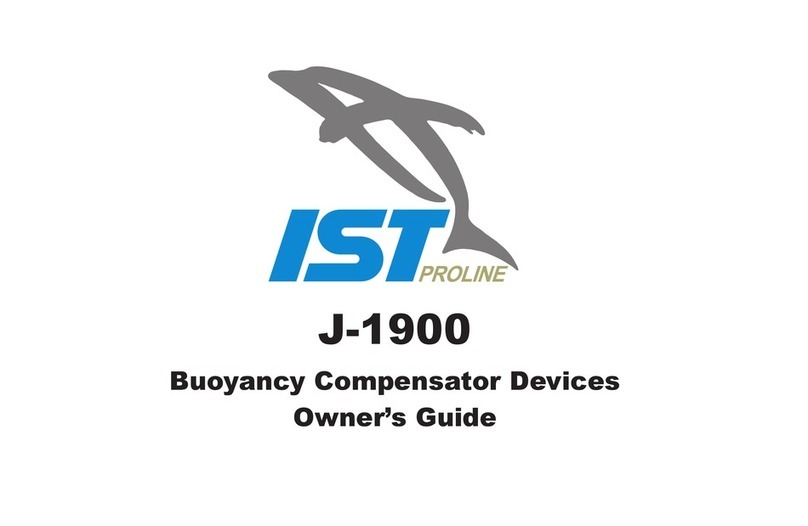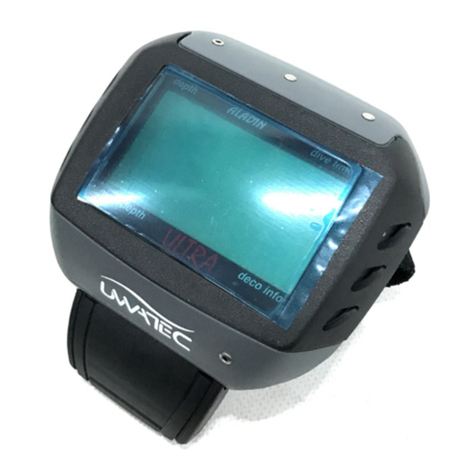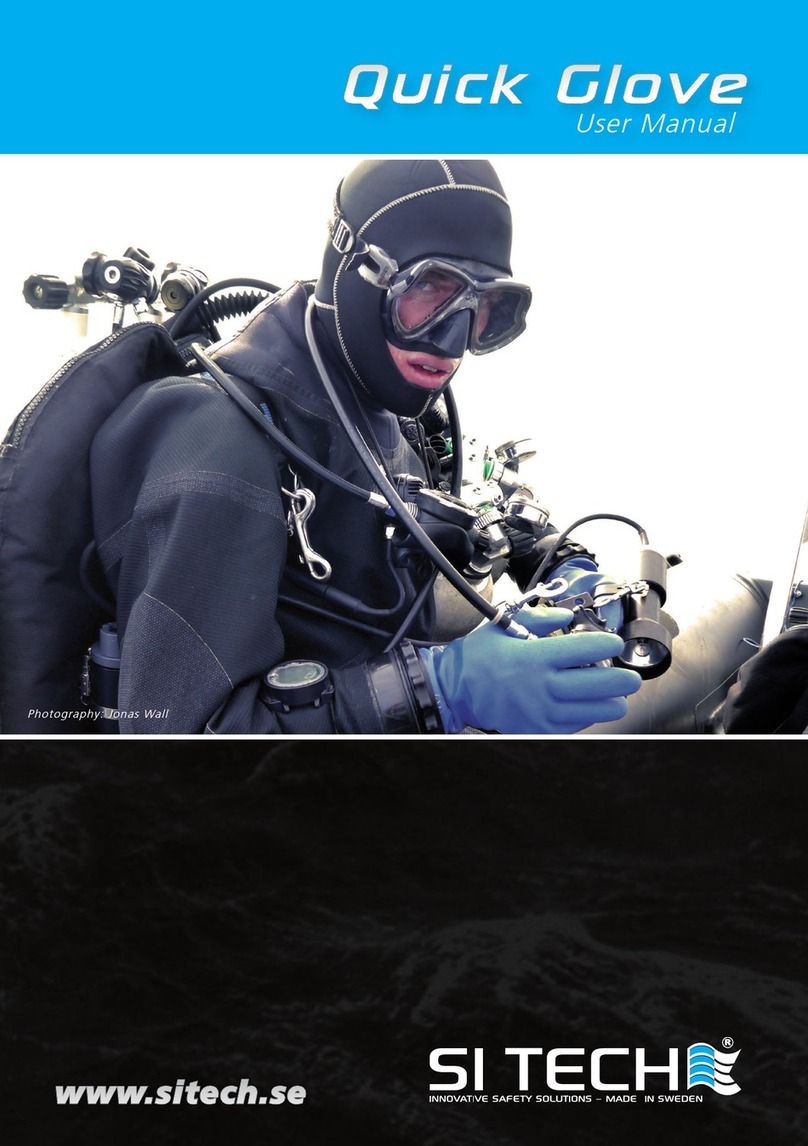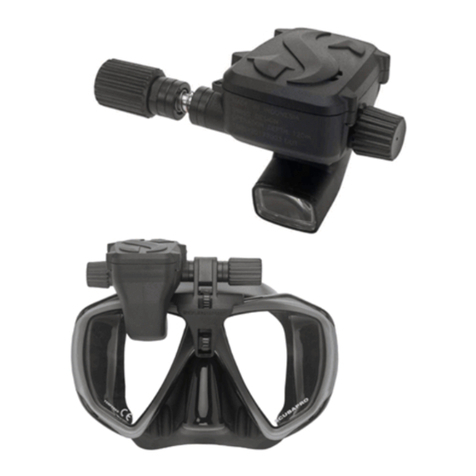Apeks TX Series User manual

TECHNICAL MAINTENANCE MANUAL
XXXXXXXXXXXXXXX
TECHNICAL MAINTENANCE MANUAL
TX Second Stage

2
Page # Rev. Date Title and/or brief description Change made by
14 12/08 New tool added, lever height
adjustment tool PN AT69
Aqua Lung
CHANGE RECORD

TX Second Stage Technical Maintenance Manual 3
CONTENTS
Copyright Notice..........................................................................................................4
General Guidelines......................................................................................................4
General Conventions ..................................................................................................4
DISASSEMBLY PROCEDURES...................................................................................5
REASSEMBLY PROCEDURES....................................................................................7
FINAL ADJUSTMENT PROCEDURES ...................................................................... 11
FINAL ASSEMBLY ..................................................................................................... 11
FINAL TESTING .........................................................................................................12
Table 1: Troubleshooting Guide ............................................................................... 13
Table 2: List of Tools and Service Kits ....................................................................14
Table 3: Torque Specications.................................................................................15
Table 4: Test Bench Specications ......................................................................... 15
Table 5: Recommended Cleaners and Lubricants ................................................. 15
Procedure A: Cleaning and Lubricating.................................................................. 16
Maintenance Notes.................................................................................................... 17
TX50 Exploded View .................................................................................................18

4
General Guidelines
1. In order to correctly perform the procedures outlined in this
manual, it is important to follow each step exactly in the order
given. Read over the entire manual to become familiar with all
procedures before attempting to disassemble the product in this
manual, and to learn which specialty tools and replacement parts
will be required. Keep the manual open beside you for reference
while performing each procedure. Do not rely on memory.
2. All service and repair should be carried out in a work area
specically set up and equipped for the task. Adequate lighting,
cleanliness, and easy access to all required tools are essential for
an efcient repair facility.
3. As the regulator is disassembled, reusable components should
be segregated and not allowed to intermix with nonreusable parts
or parts from other units. Delicate parts, including inlet ttings and
crowns which contain critical sealing surfaces, must be protected
and isolated from other parts to prevent damage during the clean-
ing procedure.
4. Use only genuine Aqua Lung parts provided in the overhaul
parts kit for this product. DO NOT attempt to substitute an Aqua
Lung part with another manufacturer’s, regardless of any similarity
in shape or size.
5. Do not attempt to reuse mandatory replacement parts under any
circumstances, regardless of the amount of use the product has
received since it was manufactured or last serviced.
6. When reassembling, it is important to follow every torque
specication prescribed in this manual, using a calibrated torque
wrench. Most parts are made of either marine brass or plastic, and
can be permanently damaged by undue stress.
7. In order to make the regulator compatible with nitrox up to 40%
O2 (EAN40), the regulator must be properly cleaned, lubricated
and assembled using genuine Aqua Lung® or Apeks replacement
parts. In addition, assembly must be carried out in a clean
environment using powderless, latex gloves or equivalent. For
more detailed information, be sure to read Procedure A: Cleaning
and Lubrication at the back of this manual.
General Conventions
Unless otherwise instructed, the following terminology and techniques
are assumed:
1. When instructed to remove, unscrew, or loosen a threaded
part, turn the part counterclockwise.
2. When instructed to install, screw in, or tighten a threaded
part, turn the part clockwise.
3. When instructed to remove an o-ring, use the pinch method
(see illustration below) if possible, or use a brass or plastic o-ring
removal tool. Avoid using hardened steel picks, as they may dam-
age the o-ring sealing surface. All o-rings that are removed are
discarded and replaced with brand new o-rings.
Pinch Method
Press upwards on sides of o-ring to
create a protrusion. Grab o-ring or
insert o-ring tool at protrusion.
4. The following acronyms are used throughout the manual: MP is
Medium Pressure; HP is High Pressure; LP is Low Pressure.
5. Numbers in parentheses reference the key numbers on the
exploded parts schematics. For example, in the statement,
“...remove the o-ring (7) from the crown (8)...”, the number 7 is
the key number to the crown o-ring.
Copyright Notice
This manual is copyrighted, all rights reserved. It may not, in whole or in
part, be copied, photocopied, reproduced, translated or reduced to any
electronic medium or machine-readable form without prior consent in
writing from Aqua Lung America. It may not be distributed through the
internet or computer bulletin board systems without prior consent in
writing from Aqua Lung America.
©2008 Aqua Lung America, Inc.
Apeks TX Second Stage Technical Maintenance Manual
Introduction
This manual provides factory prescribed procedures for the correct
service and repair of the Aqua Lung®or Apeks regulator products
described in this manual. It is not intended to be used as an instructional
manual for untrained personnel.
The procedures outlined within this manual are to be performed only by
personnel who have received Factory Authorized training through an
Aqua Lung Service & Repair Seminar. If you do not completely under-
stand all of the procedures outlined in this manual, contact Aqua Lung®to
speak directly with a Technical Advisor before proceeding any further.
Warnings, Cautions, & Notes
Pay special attention to information provided in warnings, cautions and
notes that are accompanied by one of these symbols:
WARNINGS indicate a procedure or situation that may
result in serious injury or death if instructions are not
followed correctly.
CAUTIONS indicate any situation or technique that will
result in potential damage to the product, or render the
product unsafe if instructions are not followed correctly.
NOTES are used to emphasize important points, tips
and reminders.
Scheduled Service
If the regulator is subjected to less than 50 dives per year, it is
permissible to overhaul it every other year with an inspection
procedure being performed on the “off” years. For example:
Year #1: Inspection
Year #2: Overhaul
Year #3: Inspection
Year #4: Overhaul, and so on.
Both Inspections and Overhauls need to be documented in the Annual
Service & Inspection Record in the back of the Owner’s Manual to keep
the Limited Lifetime Warranty in effect. If a regulator is subjected to more
than 50 dives per year, it should receive the complete overhaul.
An Ofcial Inspection consists of:
1. A pressurized immersion test of the entire unit to check
for air leakage.
2. Checking for stable intermediate pressure that is within
the acceptable range.
3. Checking for opening effort that is within the
acceptable range.
4. Checking for smooth operation of the control knob and
venturi switch.
5. A visual inspection of the lter for debris or discoloration.
6. A visual inspection of the exhaust valve to see that it is in
good shape and that it’s resting against a clean surface.
7. A visual inspection of the mouthpiece looking for tears
or holes.
8. Pulling back hose protectors and checking that the hoses
are secure in the hose crimps.
If a regulator fails item #1,2,3 or 4, the entire regulator should be
overhauled. If a regulator fails 4,5,6 or 7, it will be up to the technician’s
discretion whether or not a full overhaul is required.
NOTE: A unit that receives heavy or frequent use, such as rental,
instruction, or commercial applications, should be serviced at least
twice a year - or more often - depending on the conditions of use
and the manner in which it is maintained. (Refer to the care and
maintenance procedures outlined in the Regulator Owner’s Manual.)

TX Second Stage Technical Maintenance Manual 5
CAUTION: Use only a plastic or brass o-ring
removal tool (pn 944022) when removing o-rings
to prevent damage to the sealing surface. Even
a small scratch across an o-ring sealing surface
could result in leakage. Once an o-ring sealing
surface has been damaged, the part must be
replaced with new. DO NOT use a dental pick or
any other steel instrument.
1Using two 11/16” wrenches, hold the heat exchanger (2)
stationary while turning the hose swivel counterclockwise.
Remove the o-ring from inside the hose swivel. Exercise
caution not to scratch the o-ring groove. Remove the o-ring
from the male end of the hose.
2Pull back the two hose protectors and inspect the hose
crimps. If either crimp is damaged or the hose is pulling out
of the crimp then the hose must be replaced.
4Lift out the diaphragm cover (8) and diaphragm (9).
5Using an 11/16” wrench, remove the heat exchanger (2).
6Turn the adjusting knob (23) counter clockwise until it
stops. Press the lever (21) against the valve spindle (20).
While keeping the lever depressed, grasp the knob and pull
the valve spindle assembly out of the case (10). Remove
the valve spindle o-ring (3) that could be left behind in the
left side of the case.
3Using the Apeks front cover tool (pn AT31), unscrew the
case cover (7). To remove the purge button and spring (5 &
6), squeeze two opposite tabs inward.
NOTE: Ensure that the tool is rmly pressed against
the case cover while removing.
NOTE: Before performing any disassembly, refer
to the exploded parts drawing, which references all
mandatory replacement parts. These parts should
be replaced with new, and must not be reused
under any circumstances – regardless of the age of
the regulator or how much use it has received since
it was last serviced.
Disassembly

6
8Turn the adjusting screw (23) clockwise (inward) one turn.
The spring pin (17) should drop out. If the pin remains in the
valve spindle (20), use the seat extraction tool (pn 109437)
to push it partially out, then use needle nose pliers to
completely remove it from the valve spindle.
9Unthread the adjusting screw (23) counter clockwise and
completely remove it from the valve spindle (20). Remove
plug (22) from adjusting screw using a small at blade
screwdriver.
12 Using a ngernail, remove the MP seat (29) and small
o-ring (27) from the shuttle valve (28).
13 Using a medium blade screwdriver or a 5mm hex
key, turn the seat (18) six to seven full turns counter
clockwise. Since the seat is o-ring sealed, it will not
completely unscrew from the valve spindle. Insert the seat
extraction tool into the valve spindle (20), and push the seat
completely out.
11Insert a small wooden dowel into the threaded
end of the valve spindle and push out the shuttle valve
assembly (25-29). Separate the shuttle valve assembly
by pulling on each end.
7Grasp the venturi lever (16) and pull it out of the case (10).
Remove the o-ring (12) from the venturi lever.
NOTE: The venturi lever may have come out with the
valve spindle in step 6. If this is the case, depress the
lever and slide the venturi lever off from right to left.
10 Remove the o-ring (24) from the adjusting screw (23).
Remove the o-ring (3) from the valve spindle (20).
1 4 Remove the o-ring (19) from the seat (18). Closely examine
the seat for any scoring or nicks. If damage is found,
discard the seat. Do not attempt to reuse. If the seat is in
reusable condition, set it aside on a soft surface to prevent
damage to the sealing edge.
Sealing Edge
O-ring Groove

TX Second Stage Technical Maintenance Manual 7
16 To remove the exhaust tee (15), squeeze the two exhaust
ports together. Pull the tee away from the case (10).
17 Fold back the edges of the exhaust valve (11) and inspect
underneath. The seating surface should be clean and free
of damage. Inspect the exhaust valve. It should be supple
and have well dened edges. If it looks good, there is no
need to remove it and it may be reused. If there is any sign
of deterioration, it should be replaced.
NOTE: If the exhaust valve (11) is to be removed, pinch
edge of exhaust valve and pull tail through hole in case (10).
18Using side cutters, snip the mouthpiece clamp (13).
Remove the mouthpiece (14).
1If the exhaust valve (11) was removed, replace by threading
the tail through the retaining hole on the outside of the case
(10) until the barb engages on the inside. Align the rib so it
is horizontal. If the valve is new, cut off the excess stem with
side cutters leaving approximately 5mm of the tail behind.
2Position the exhaust tee (15) with the case (10). Clip one
corner of the tee onto the case. Stretch the other corner
over the case and then stretch the bottom of the tee onto
the case.
15
If the lever (21) is to be removed, carefully pull one of the legs
out of the valve spindle and then ease the second leg out.
NOTE: Lever does not need to be removed during service,
unless following inspection it appears to be bent or mishapen.
This Ends Disassembly
Before starting reassembly, perform parts cleaning and
lubrication according to the procedures outlined in
‘Cleaning & Lubrication’ on page 16.
WARNING: Flooding may occur if the tail of the
valve is not fully pulled through. Check that barb has
engaged on inside of case.
Reassembly

8
3Install the o-ring (3) onto the valve spindle (20).
4Install the o-ring (27) onto the stem of the shuttle valve (28).
Push the MP seat (29) into the front of the shuttle valve.
NOTE: Ensure MP seat has been tted ush with the
shuttle valve.
5Fit the valve spring (26) onto the leading edge of the counter
balance cylinder (25). Carefully guide the stem of the shuttle valve
through the spring and into the counter balance cylinder.
7With the “feet” of the shuttle valve (28) pointing downward
(away from the lever) and the lever (21) pointing straight up
(perpendicular to the valve spindle), insert the valve assembly
(25-29) into the valve spindle. Using your nger, press the
shuttle valve assembly all the way into the valve spindle.
CAUTION: Ensure that lever is not twisted and that
legs are parallel. Lever should appear as that shown
on the left, not as shown on the right. If necessary,
gently squeeze legs together to straighten.
6Install the lever (21) in correct orientation. With air outlet
hole facing you and threaded end to the right, lever should
be pointing to the left.
NOTE: Ensure that the lever has a full range of
movement and does not catch on the valve spindle.
8Install the o-ring (24) onto the adjusting knob (23).
Feet Point Down

TX Second Stage Technical Maintenance Manual 9
9Install the adjusting knob (23) into the valve spindle (20).
There should now be spring tension on the lever. Continue
to screw clockwise until the holes for the spring pin are
clear. Install the spring pin (21). Be sure that it sits evenly in
the hole. Back the adjusting knob out counter clockwise to
apply tension to the pin and keep it from falling out.
10 Install the o-ring (12) onto the venturi lever (16). Point
the venturi lever upward and insert it into the case (10).
Press it against the case so the o-ring is seated in the
groove.
11 While depressing the lever (21), insert the valve spindle
(20) through the venturi lever (16) and into the case (10).
Be sure the valve spindle engages the two index ats molded
into the case.
12 Slide the o-ring (3) down the threaded end of the valve
spindle (20). Screw the heat exchanger (2) clockwise
with the hexagon facing outward, onto the valve spindle
until hand tight. Using an 11/16” crow-foot, tighten the heat
exchanger to a torque of 45 in/lbs (5 Nm).
CAUTION: Ensure that the lever is vertical after
tightening.
CAUTION: Excessive tightening of the heat exchanger
will damage the two ats inside the case.
13 Fit the o-ring (19) onto the seat (18). Press the seat,
threaded end rst, into the valve spindle. Using the seat
installation tool, push the seat into the valve spindle as far
as it will go.

10
14 While holding the rim of the case (10) at eye level, use
a medium blade screwdriver or 5mm hex key to turn the
seat (18) clockwise until the lever drops about 4mm below
the case rim. Then, turn the seat counter clockwise until the
lever is level with the case rim.
15 Position the diaphragm (9) into the case (10). Using your
nger, work the edges of the diaphragm into place so it sits
evenly in the case . Install the diaphragm cover (8) into the
case (10), over the diaphragm.
16 Place the small diameter end of the spring (6) onto the
purge button (5). Orient the case cover (7) with the slotted
openings pointing to the right. Properly align the purge button
and press it into the case cover until it snaps into place.
17 Thread the case cover (7) onto the case (10) by hand until
snug. Using the cover tool (pn AT31) tighten the cover until it
stops. Conrm that the purge button is properly aligned.
19 Add the o-ring to the male end of the hose. Install the
o-ring into the swivel end of the hose.
CAUTION: Inspect the diaphragm strike plate for any
signs of distortion. If the strike plate shows any sign
it must be replaced with a new one. See Technical
Bulletin #17, April 4, 2006.
NOTE: It is recommended that the nal adjustment be
performed prior to installing the mouthpiece. Refer to
Final Adjustment Procedures on page 11.
This Ends Reassembly
NOTE: Perform the following suction test prior to t-
ting the hose: hold your thumb over the valve spindle
to seal, then breath through the mouthpiece outlet
port. You should not be able to draw air in.
1 8 Replace the plug (22) into
the adjustment knob (23).

TX Second Stage Technical Maintenance Manual 11
1 Depressurize the regula-
tor and remove the in-line
adjustment tool from the
MP hose and the 2nd stage.
Thread the MP hose onto
the second stage. While
holding the heat exchanger
(2) stationary with an 11/16”
open end wrench. Use an
in/lb torque wrench and a
11/16” crow-foot to torque
the hose to 45 in/lbs (5 Nm).
2 If equipped with a comfo-
bite mouthpiece (14),
make sure the ‘bridge’ of
the mouthpiece is facing
upward. Install the mouth-
piece over the outlet port.
Install the mouthpiece
clamp (13) in the groove so
that the buckle points to-
ward the hose. Tighten the
clamp and snip the excess
with side cutters.
WARNING: Ensure that the mouthpiece is properly
secured on the oral boss.
2 Make sure that the adjustment knob (23) is loosened and that
the venturi lever (16) is set to the “+” position.
WARNING: Compressed air can be highly explosive
and is dangerous if misused. Ensure cylinder valve
is opened slowly. Use Eye and Ear Personal Protec-
tive Equipment when performing any tests involving
compressed air .
4 Place the “NO GAS FLOW”
end of the TX lever height
tool (pn AT69) onto the
purge button (5). Depress
the purge button by push-
ing the tool towards the
second stage until it stops
against the front cover. If
air does not ow from the
second stage, proceed to
step 6. If air ows from the
valve, proceed to step 5.
3 Give a quick tap to the purge button. This will cause the reg
to freeow. Stop the freeow after a couple of seconds by
placing a hand over the mouthpiece.
1 Attach the in-line
adjustment tool (pn
100190) to the 2nd stage.
Attach the 2nd stage to a
properly adjusted rst stage
or calibrated test bench.
Slowly pressurize the
system to 3,000 psi (206
Adjusting Lever Height
5 Using the in-line adjustment tool, turn the seat (18) clockwise
approximately 1/16 of a turn. Repeat step 4.
6 Place the “GAS FLOW”
end of the TX Lever Height
Tool onto the purge button
decal (1). Depress the
purge button by pushing
the tool towards the second
stage until it stops against
the front cover. If air ows
from the second stage the
lever height has been set
correctly. If air does not
ow from the valve, pro-
ceed to step 7.
2nd Stage Opening Effort Test
1 With the regulator still pressurized, slowly open the owmeter
control knob (start vacuum) while watching both the
magnehelic gauge and the MP gauge.
2 When the MP begins to drop, indicating the second stage
valve is open, the magnehelic gauge should indicate an
opening effort of +1.0 to +1.5 in/H2o (2.5-3.7 mbar) If the
reading is outside of these specications, reference Table 1,
Troubleshooting Guide (pg 13) for corrective actions.
FINAL ASSEMBLY
Final Adjustment Procedures
7 Using the in-line adjustment tool, turn the seat (18) counter-
clockwise approximately 1/16 of a turn. Repeat from step 4.

12
FINAL TESTING PROCEDURES
External Leak Test
1. After disconnecting the regulator from the test bench, connect
it to a scuba cylinder lled to approximately 3000 psi (206 bar).
Open the cylinder valve to pressurize the regulator and sub-
merge the entire system in a test tank of clean water.
2. Observe any bubbles arising from the submerged regulator
over a one minute period. The recommended time is neces-
sary due to slower bubble formation that occurs in smaller
leaks. Bubbles indicate a leak, this would require the system
to be disassembled at the source to check sealing surfaces,
assembly sequence and component positioning in order to cor-
rect the problem(s).
NOTE: Extremely small leaks may be better detected
by applying a soap solution or Snoop™ to the leak area.
Bubble streams will indicate the source of the leak.
Before disassembling to correct any leaks, rinse the
entire regulator thoroughly with fresh water and blow
out all residual moisture with ltered, low-pressure (50
psi) air. Disassemble and remedy the problem, referring
to Table 1: Troubleshooting Guide, p. 13.
Subjective Breathing Test
1. Depress the second stage purge to ensure that the
volume of airow is adequate to clear the second stage.
2. Breathe deeply from the mouthpiece. A properly serviced
and adjusted regulator should deliver a smooth, uninterrupted
airow upon deep inhalation; without excessive effort,
hesitation, or freeow. If any abnormalities or problems occur,
refer to Table 1: Troubleshooting Guide, p. 13.
When completed, close the cylinder valve and depressurize the
regulator. Remove the rst stage from the valve and secure the
dust cap in place.
THIS CONCLUDES THE SERVICE PROCEDURES
FOR THE TX SECOND STAGE REGULATOR.

TX Second Stage Technical Maintenance Manual 13
SYMPTOM POSSIBLE CAUSE TREATMENT
Leakage or freeow from TX Sec-
ond Stage
1. Excessively high rst-stage
intermediate pressure.
1. Refer to rst-stage
Troubleshooting Guide.
2. MP Seat (29) damaged or worn. 2. Replace Rubber Seating.
3. Seat (18) adjusted incorrectly, Lever
(21) set too high.
3. Reset Seat preliminary
settings, and repeat Adjustment
Procedures.
4. Lever (21) bent. 4. Replace Lever.
5. Seat (18) sealing surface damaged. 5. Replace Valve Seat.
6. Valve Spring (26) damaged. 6. Replace Spring.
7. Shuttle Valve o-ring (27) damaged. 7. Replace o-ring.
8. Counter Balance Cylinder (25) bore
damaged.
8. Replace Counter Balance
cylinder.
Low purge or excessive work of
breathing (full cylinder)
1. Low rst-stage intermediate
pressure.
1. Refer to rst-stage
Troubleshooting Guide.
2. Seat (18) adjusted incorrectly, Lever
(21) set too low.
2. Reset Seat preliminary
settings, and repeat Adjustment
Procedures.
3. Intermediate pressure hose clogged
or obstructed. 3. Clean or replace Hose.
4. Lever (21) bent or catching on Valve
Spindle (20). 4. Replace Lever.
Water entering TX Second Stage
1. Mouthpiece (14) damaged or incor-
rectly tted.
1. Replace or re-t Mouthpiece as
appropriate.
2. Diaphragm (9) damaged. 2. Replace Diaphragm.
3. Diaphragm (9) improperly seated in
Case (10).
3. Remove Front Cover (7) and
Diaphragm Cover (8) properly
reassemble Diaphragm (check
for distortion).
4. Exhaust Valve (11) damaged. 4. Replace Exhaust Valve.
5. Case (10) damaged. (Check exhaust
valve seating surface.) 5. Disassemble and replace Case.
6. Heat exchanger o-ring (3) damaged. 6. Replace o-ring
Table 1: Troubleshooting Guide

14
PART # DESCRIPTION APPLICATION
100190 In-line Adjustment
Tool Final adjustment and tuning
111605 In-line Test
Gauge MP testing
109437
Seat
Installation
Tool
Seat (18) removal/replacement
944022 O-ring Tool
Set Removing and installation of o-rings
AT31 TX/ATX Cover
Tool Assembly/disassembly of case cover (7)
AT69 Lever Height Tool Lever Height Measurement
N/A 11/16” Open
End Wrench Assembly and disassembly of heat exchanger (2)
N/A Side Cutters Cut clamp (13) for exhaust valve (11)
N/A 11/16” Crow Foot Apply torque to parts listed in Table 3:
Torque Specications, p. 15
N/A Medium Blade
Screwdriver Seat (18) removal and replacement
N/A Torque Wrench
(30 - 120 in/lbs)
Apply torque to parts listed in Table 3: Torque Specications,
p. 15
N/A Magnier with
Illumination Sealing surface inspection
N/A Ultrasonic Cleaner Brass and stainless steel parts cleaning
Table 2: List of Tools and Service Kits

15
TX Second Stage Technical Maintenance Manual
Table 3: Torque Specications
PART # DESCRIPTION / KEY ITEM # TORQUE
AP5002 Heat Exchanger / Spacer (2) 45 in/lbs / 5 Nm
AP0203 Hose 45 in/lbs / 5 Nm
Table 4: Test Bench Specications
TEST CONDITION SPECIFICATION
Leak Test Inlet 2500 - 3000 psig (206 bar) No leaks allowed
MP Inlet 2500 - 3000 psig (206 bar) 130 - 145 psi (9 - 10 bar)
Opening Effort Inlet 2500 - 3000 psig
MP 130 - 140 psi (9 - 10 bar) + 1.0 - 1.5 H20 (2.5 - 3.7 mbar)
Table 5: Recommended Cleaners and Lubricants
LUBRICANT/CLEANER APPLICATION SOURCE
Christo-Lube MCG 111 All o-rings
Aqua Lung, PN 820466, or
Lubrication Technologies
310 Morton Street
Jackson, OH 45640
(800) 477-8704
Oakite #31 Acid bath for reusable stainless steel and
brass parts.
Oakite Products, Inc.
50 Valley Road
Berkeley Heights, NJ 07922
White distilled vinegar Acid bath for reusable stainless steel
and brass parts. “Household” grade
Liquid dishwashing detergent
(diluted with warm water)
Degreaser for brass and stainless steel
parts; general cleaning solution for plastic
and rubber.
“Household” grade
CAUTION: Silicone rubber requires no lubrication or preservative treatment.
DO NOT apply grease or spray to silicone rubber parts. Doing so may cause
a chemical breakdown and premature deterioration of the material.
CAUTION: Do not use muriatic acid for the cleaning of any parts. Even if
strongly diluted, muriatic acid can harm chrome plating and may leave a
residue that is harmful to o-ring seals and other parts.

16
Aqua Lung and Apeks First Stages and Nitrox
When it comes to issues of nitrox safety and compatibility, the concerns lie primarily with the rst stage as it is subjected to high inlet
pressures. High inlet pressures lead to adiabatic compression or heating of the gas. The Aqua Lung or Apeks regulator product
described in this manual, when properly cleaned and assembled, is authorized for use with enriched air nitrox (EAN) that does not
exceed 40% (EAN 40). It is authorized because it has undergone adiabatic compression testing and the authorized service kit
components and lubricants are compatible in elevated oxygen environments. During cleaning, a mild detergent must be used to remove
condensed hydrocarbons (compressor oils) from the inside passageways of the rst stage. For the rst stage to remain EAN40
compatible, only use hyper ltered compressed gas (hydrocarbons < 0.1 mg/m3). Ordinary compressed breathing air (Grade E) usually
does not meet this criterion. Once ordinary breathing air is used, the rst stage is no longer EAN40 compatible until it is cleaned and
serviced again.
Although regulator second stage components are not exposed to high pressure EAN, Aqua Lung recommends that the same cleaning
procedures be followed for the complete regulator. This prevents the possibility of cross contamination and guarantees the cleanliness
of the entire regulator.
Cleaning Brass and Stainless Steel Parts
1. Preclean in warm, soapy water* using a nylon bristle tooth brush.
2. Thoroughly clean parts in an ultrasonic cleaner lled with soapy water. If there are stubborn deposits, household white distilled
vinegar (acetic acid) in an ultrasonic cleaner will work well. DO NOT place plastic, rubber, silicone or anodized aluminum parts
in vinegar.
3. Remove parts from the ultrasonic cleaner and rinse with fresh water. If tap water is extremely “hard,” place the parts in a bath
of distilled water to prevent any mineral residue. Agitate lightly, and allow to soak for 5-10 minutes. Remove and blow dry
with low pressure (25 psi) ltered air, and inspect closely to ensure proper cleaning and like-new condition.
Cleaning Anodized Aluminum, Plastic & Rubber Parts
Anodized aluminum parts and parts made of plastic or rubber, such as box bottoms, box tops, dust caps, etc., may be soaked and
cleaned in a solution of warm water mixed with mild dish soap. Use only a soft nylon toothbrush to scrub away any deposits. Rinse in
fresh water and thoroughly blow dry, using low pressure ltered air.
CAUTION: Do not place plastic and rubber parts in acid solutions.
Doing so may alter the physical properties of the component,
causing it to prematurely degrade and/or break.
Cleaning Hoses
1. Hose ttings: Ultrasonically clean with soapy water*; vinegar OK on tough corrosion
2. Run soapy water through hose if needed
3. Thoroughly rinse with fresh water
4. Blow out hose before installing
Lubrication and Dressing
Wear powderless, latex gloves when handling and lubricating o-rings. Keeping internal parts free from skin oils and other contaminates
is important when running enriched air nitrox through a rst stage. All o-rings should be lubricated with Christo-Lube®MCG-111. Dress
the o-rings with a very light lm of grease, and remove any visible excess by running the o-ring between thumb and forenger. Avoid
applying excessive amounts of Christo-Lube® grease, as this will attract particulate matter that may cause damage to the o-ring.
*Soapy water is dened as “household” grade liquid dishwashing detergent diluted in warm water.
Procedure A: Cleaning and Lubricating

17
Maintenance Notes

18
NOTE: Early versions of the
TX range used a separate
Heat Exchanger and Spindle Nut.
13
15
12 16
22
14
45 in/lbs
5 Nm
5
6
7
8
23
24
25
26
27
28
29
4
2
3
1
9
18 19
21
20 17
310
11
Part numbers in BOLD ITALICS indicate standard overhaul replacement part.
.......AP0510 TX50, Second Stage w/ 1/2" Hose
.......AP0219/AA Universal Second Stage Repair Kit
1.......AP2037 Deector
2.......AP5002 Heat Exchanger, TX50
3.......AP1267 O-ring
4.......AP5004/1 Decal, TX50
.......AP5019 Decal, Instructor
5.......AP2053 Purge Button
.......AP2053Y Purge Button, Nitrox, Yellow
6.......AP2020 Spring
7.......AP2026 Case Cover, TX50
.......AP2026/Y Case Cover, Yellow, Octopus or Nitrox
8.......AP2025 Diaphragm Cover
.......AP2025 GREEN Diaphragm Cover, Nitrox, Green
9.......AP2023 Diaphragm
10 .......AP5001 Case
11 .......AP1429 Exhaust Valve
12 .......AP1438 O-ring
13 .......104913 Mouthpiece Clamp
14 .......AP5324K Mouthpiece, Comfo-Bite
15 .......AP2040 Exhaust Tee
16 .......AP2039 Venturi Lever, TX50
.......AP2039 GREEN Venturi Lever, Nitrox, Green
17 .......AP1151 Spring Pin
18 .......AP2033 Seat
19 .......AP1154 O-ring
20 .......AP2028 Valve Spindle, TX50
21 .......AP2035 Lever
22 .......AP2030 Plug
23 .......AP2029 Adjusting Screw, TX50
24 .......AP1409 O-ring
25 .......AP2038 Counter Balance Cylinder
26 .......AP2021 Valve Spring
27 .......AP2041 O-ring
28 .......AP2036 Shuttle Valve
29 .......AP2034 MP Seat
Hoses (not shown)
.......AP0203 Hose, MP, Primary 1/2" UNF
Hose O-rings (not shown)
.......AP1410 O-ring, Hose End Male 1/2"
.......AP1154 O-ring, Hose Swivel
Key # . Part # Description Key # . Part # Description
TX50

Aqua Lung America
2340 Cousteau Court, Vista CA 92081
760-597-5000
www.aqualung.com
TECHNICAL MAINTENANCE MANUAL
XTX SECOND STAGE REGULATOR
Authorized Technician
Rev. 06/2008
©2008 Apeks Marine Equipment Ltd.
Aqua Lung America
2340 Cousteau Court, Vista CA 92081
760-597-5000
www.aqualung.com
TECHNICAL MAINTENANCE MANUAL
TX SECOND STAGE REGULATOR
Authorized Technician
Rev. 12/2008
©2008 Apeks Marine Equipment Ltd.
This manual suits for next models
1
Table of contents
Other Apeks Diving Instrument manuals
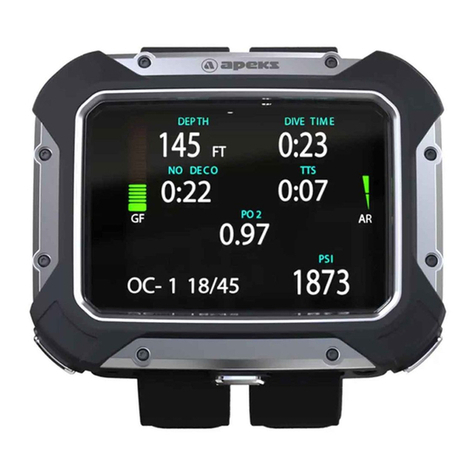
Apeks
Apeks NS158000 User manual
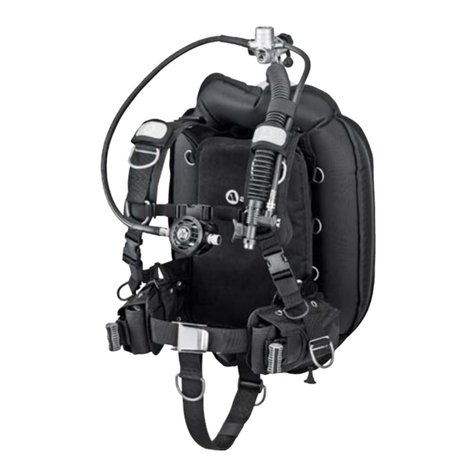
Apeks
Apeks WTX User manual
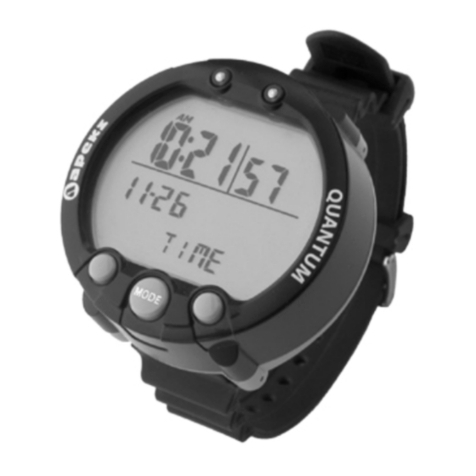
Apeks
Apeks Quantum User manual
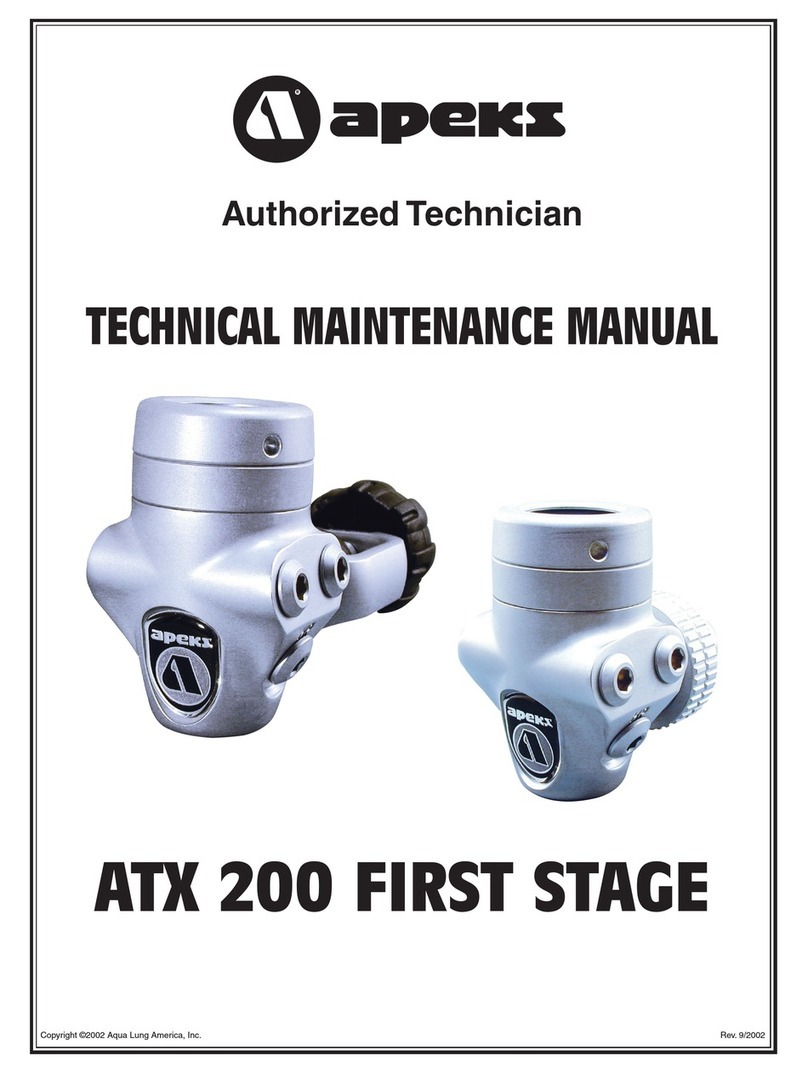
Apeks
Apeks ATX 200 User manual
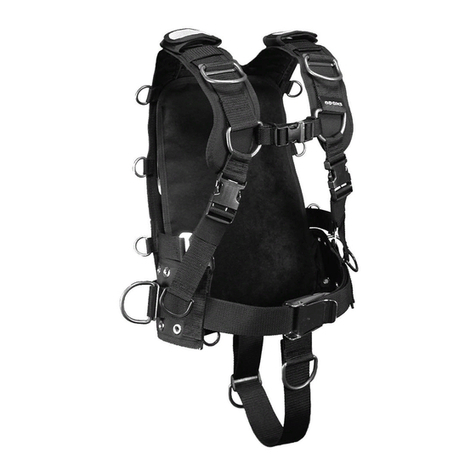
Apeks
Apeks wtx series User manual
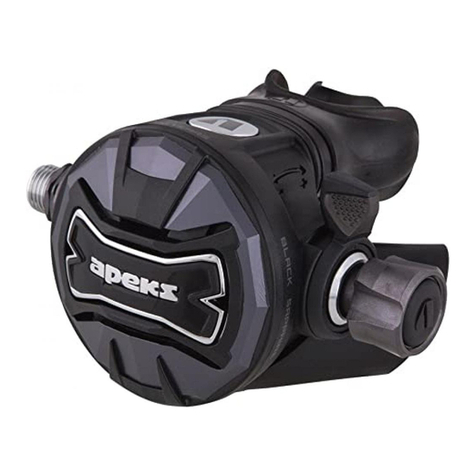
Apeks
Apeks BLACK SAPPHIRE User manual

Apeks
Apeks 427106 User manual
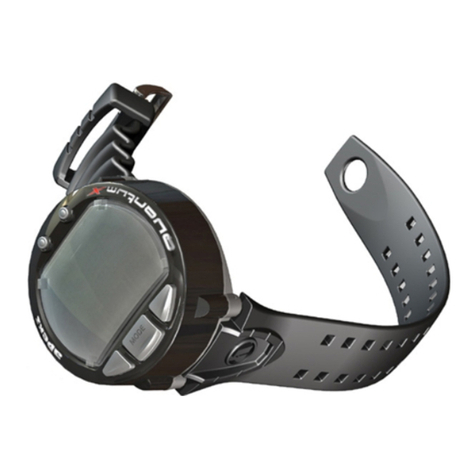
Apeks
Apeks QuantumX User manual
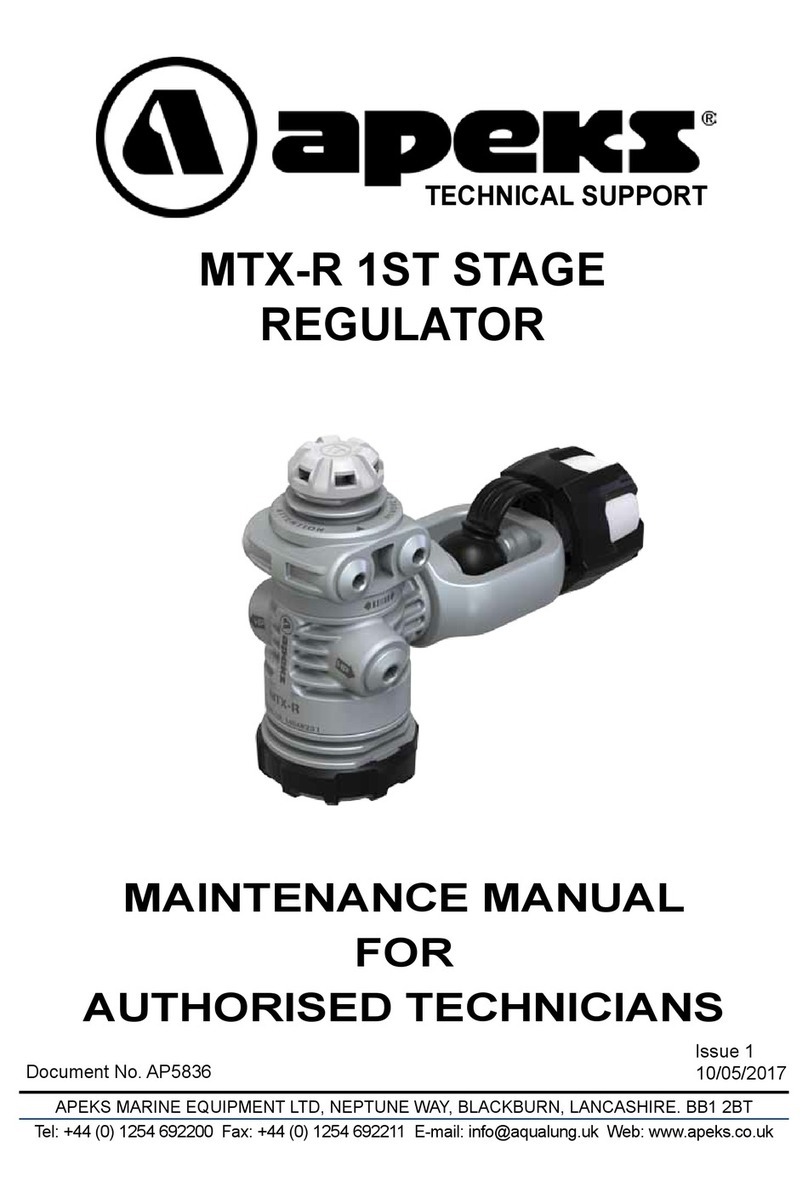
Apeks
Apeks MTX-R User manual
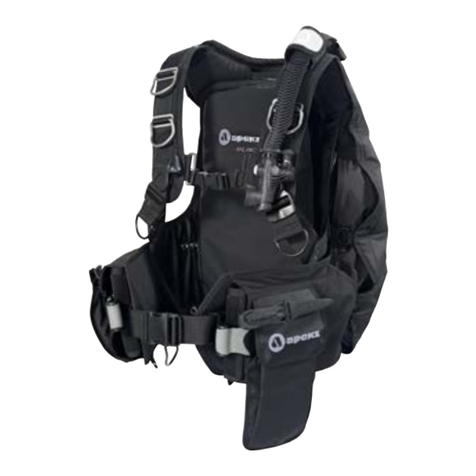
Apeks
Apeks Black Ice User manual
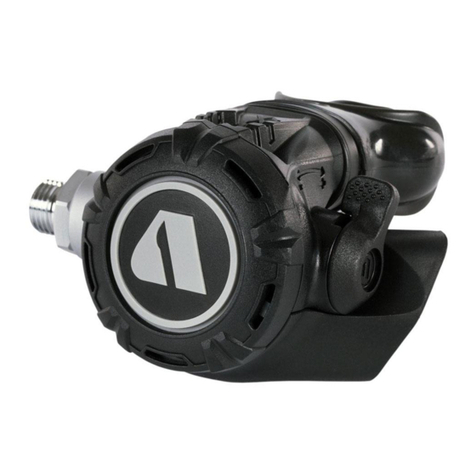
Apeks
Apeks XL4 SECOND STAGE User manual
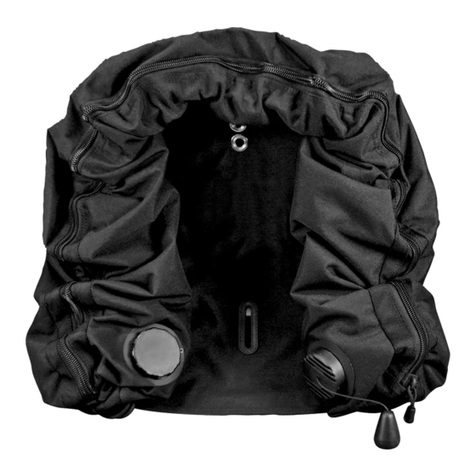
Apeks
Apeks 388300 User manual
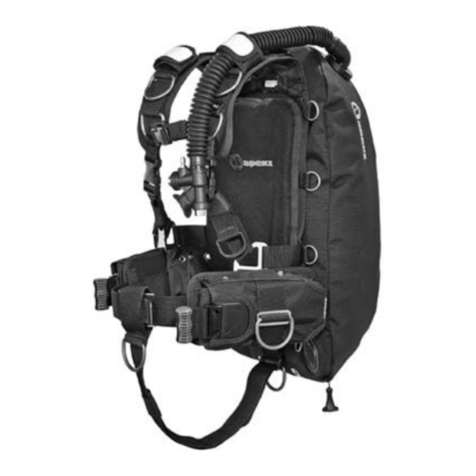
Apeks
Apeks WTX-D User manual
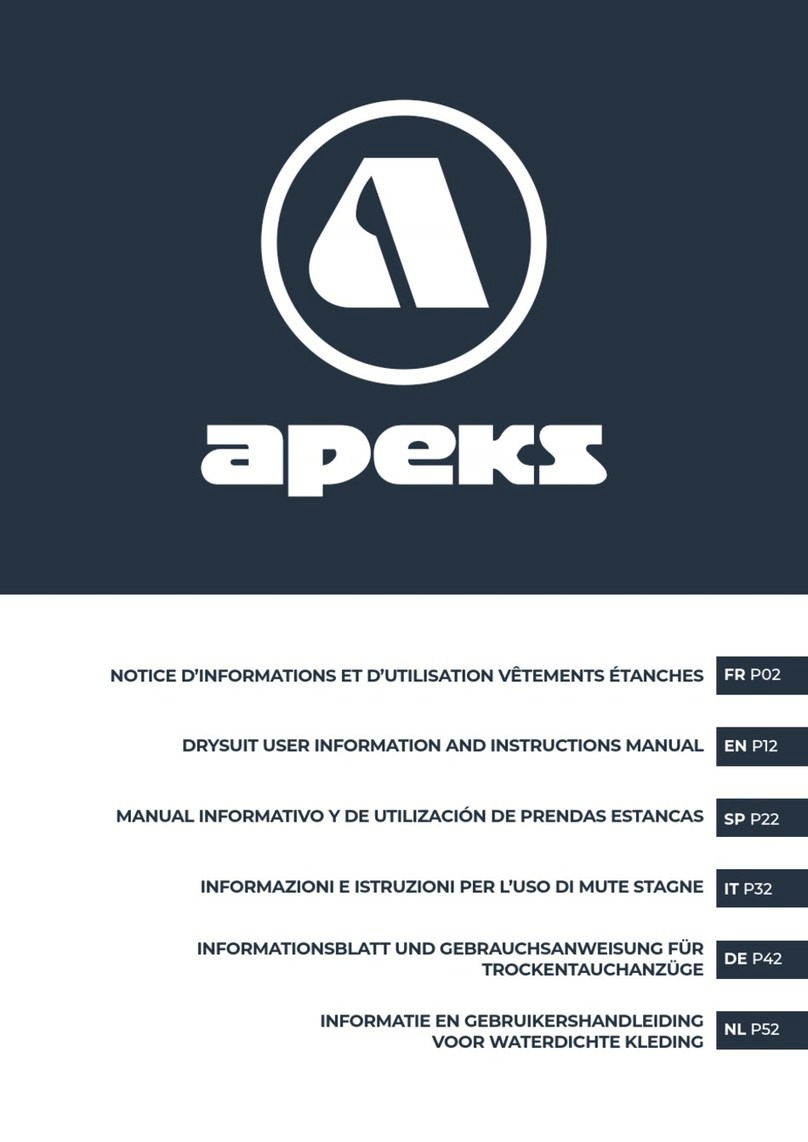
Apeks
Apeks ThermiQ Dry Advanced User manual
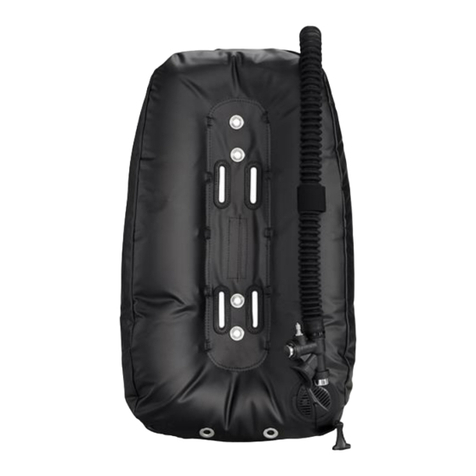
Apeks
Apeks wtx series User manual
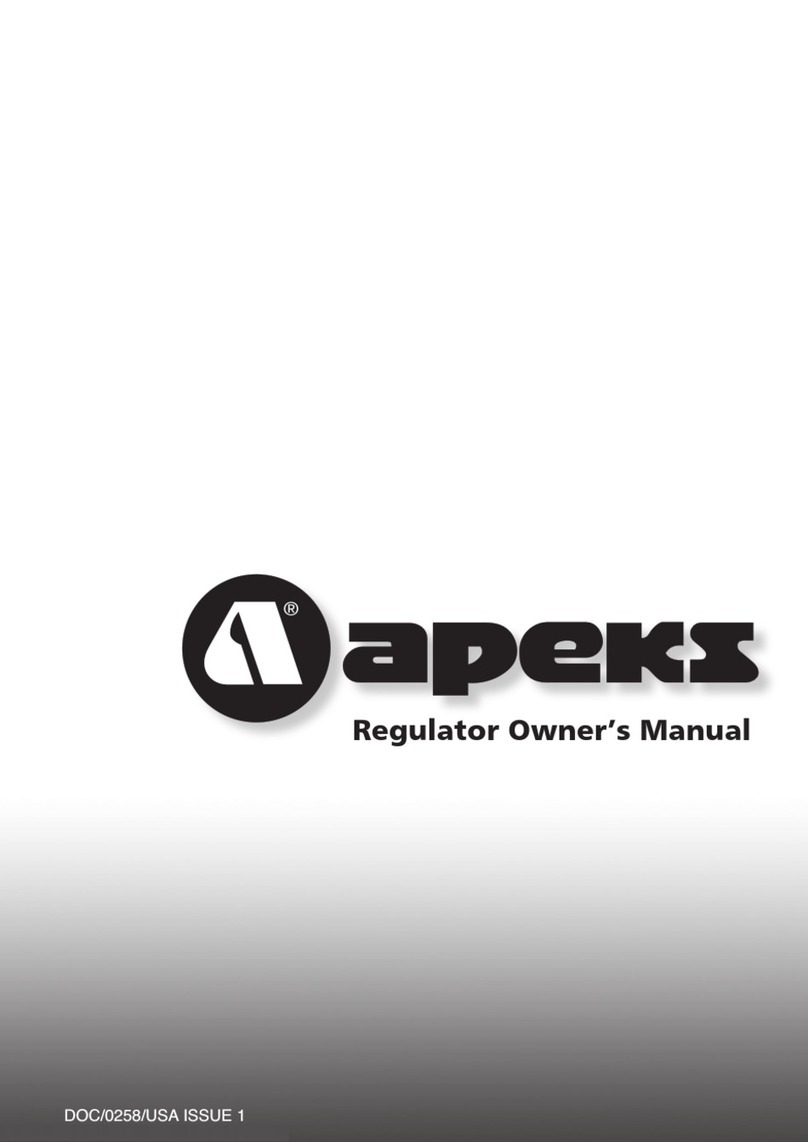
Apeks
Apeks Regulator User manual
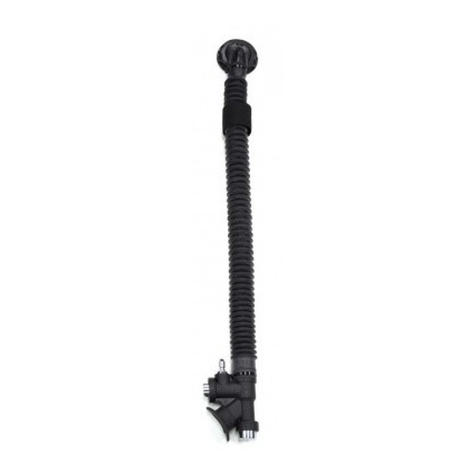
Apeks
Apeks WTX INFLATOR User manual

Apeks
Apeks wtx series User manual
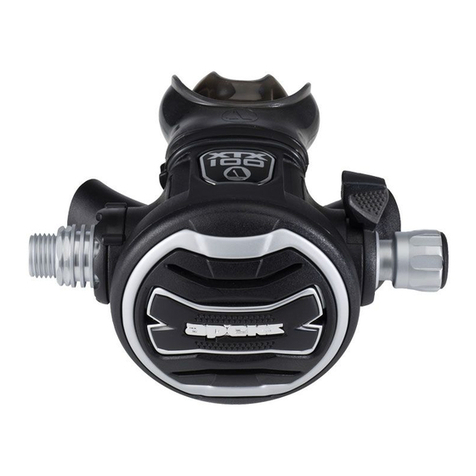
Apeks
Apeks XTX200 User manual
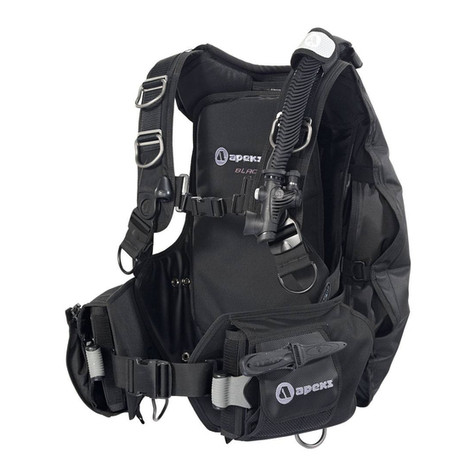
Apeks
Apeks Black Ice Twin Cylinder Kit User manual


